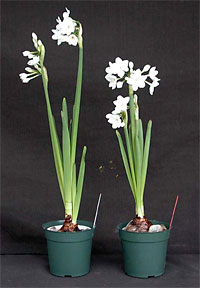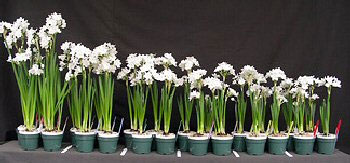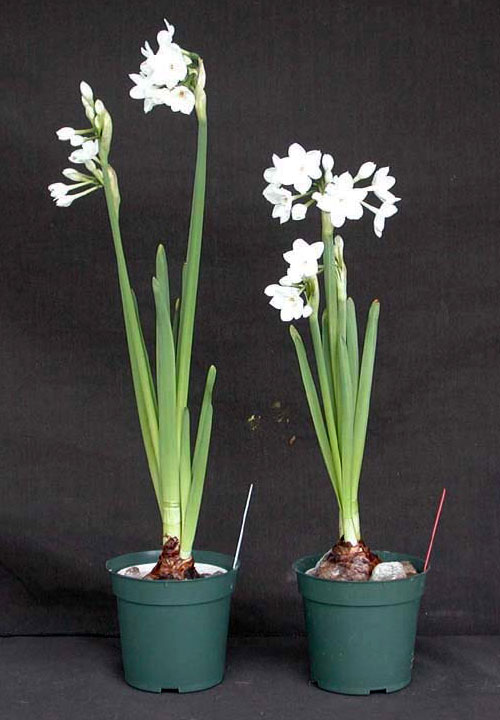
Find updated post on the Flower Bulb Research Program website.
It’s that time of year:
Thousands of flower-bulb lovers will ‘force’ paperwhites inside so they can enjoy their blooms during the darkest days of the year. And thanks to an undergrad research project carried by Erin Finan (’05) under the supervision of Bill Miller, many of those bulb-forcers won’t have to stake, tie, or otherwise support the usually floppy paperwhites.
It all started when Leslie Land from the New York Times asked Bill if the folk wisdom was true that adding liquor to water used to grow forced bulbs would keep them shorter and less likely to fall over.
Land picks up the story in her January 12, 2006 Gardening Q&A column:
“When addressed in this space last February, the gin tip elicited cautious support from Bill Miller, the director of the Flower Bulb Research Program at Cornell University. He said he could imagine how alcohol (ethanol) might promote short, sturdy stems if you added just the right amount, because it could interfere with water uptake. Flowers would not be affected but less water pressure on the stem cells would result in less cell-stretching, so stems would be shorter. But he said he doubted there could be a universal formula. ‘I can guarantee you nobody’s studied this,’ he added.
“Now someone has. With the help of one of his horticulture students, Erin Finan, Dr. Miller started running experiments. In brief, what they discovered is that stems will end up roughly a third shorter than normal if you take the following steps.
“Start your bulbs in plain water. When roots have formed and the green shoot is 1 to 2 inches long, pour off the water and replace with a solution of 4 to 6 percent alcohol. If you are using 80 proof liquor (40 percent alcohol), that works out to one part gin (or the like) to 7 parts water.
“Rubbing alcohol (either 70 or 100 percent isopropyl alcohol) can be substituted; just remember to dilute it more. Keep the beer and wine for yourself; their sugars damage plants.”
Since 2005, the results of Erin’s simple experiment have been featured in scores of magazine articles, gardening columns, newscasts and blogs around the globe, including Parade Magazine, der Spiegel, CNN, MSNBC, and NPR’s Wait Wait … Don’t Tell Me:

Here’s the original paper (or view printer-friendly .pdf file):
Pickling your Paperwhites
Using Alcohol to Reduce Growth of Paperwhite Narcissus
William B. Miller
Professor of Horticulture
Director of the Flowerbulb Research Program
Cornell University
The paperwhite narcissus is a popular bulb for indoor forcing in the winter months. Unlike most other daffodils, paperwhites (Narcissus tazetta) do not require a cold period. They are simply planted in pots with soil, or even more commonly, in dishes or bowls with gravel, marbles or other decorative material. With a little water, they rapidly form roots, grow leaves and shoots. The white, fragrant flowers usually open up within 2-3 weeks of planting.
A common problem with paperwhites, however, is that they often grow too tall and flop over. Recent research conducted by the Flowerbulb Research Program at Cornell University has found a simple and effective way to reduce stem and leaf growth of paperwhites. The “secret” is using dilute solutions of alcohol. Properly used, the result is paperwhites that are 1/3 to 1/2 shorter, with equal sized flowers that last as long as normal.
What to do:
We suggest planting your paperwhite bulbs in stones, gravel, marbles, glass beads, etc. as usual. Add water as you normally would, then wait about 1 week until roots are growing, and the shoot is green and growing about 1-2″ above the top of the bulb. At this point, pour off the water and replace it with a solution of 4 to 6% alcohol, made from just about any “hard” liquor. You can do the calculations to figure the dilution, but, as an example, to get a 5% solution from a 40% distilled spirit (e.g., gin, vodka, whiskey, rum, tequila), you add 1 part of the booze to 7 parts of water. This is an 8-fold dilution yielding 5% alcohol.
Then, simply use this solution, instead of water, for further irrigation (watering) of your bulbs. It’s as simple as that. The result will be a plant that is 1/3 shorter, but with flowers just as large, fragrant, and long-lasting as usual. But, the plant will be nicely proportioned and won’t need support stakes, wires, or other gizmos to keep it upright. You will see results within just a few days. You can have some fun by doing a simple experiment having one bowl of bulbs given normal water and the other given the alcohol. You will see a dramatic difference, as shown in the picture. This could be a neat activity to occupy kids during the upcoming holiday season!
A few other thoughts:
- Do not use beer or wine, as the sugars in them will cause major problems with the plants
- As with humans, paperwhites can also suffer alcohol overdoses! We suggest 4-6% alcohol as a normal and safe range. If plants are given much more than 10% alcohol, growth problems will start, and 25% alcohol is dramatically toxic. So, moderation is the key!
- It is not strictly necessary pour off the water after the plants are rooted (as we suggest above). You can just as well add your 5% alcohol without pouring the water off. The result, though, will be a lower than optimal alcohol concentration around the roots, and, ultimately, growth will not be reduced as much as you expect. The reason to pour off the water is to simply maximize the alcohol level around the roots.
- Basically, the higher the alcohol concentration (within reason), the shorter the plants. So it is not critical whether you use 4, 5, or 6% alcohol. Just stay well below 10%, where growth problems become noticeable.
- If you do not have alcohol for consumption in your household, rubbing alcohol (isopropyl alcohol) works just as well. Since this is usually 70% alcohol when purchased, a dilution of 1 part rubbing alcohol to 10 or 11 parts water is appropriate.
- Why does this happen? We are currently working on this, but we feel it is simply “water stress,” where the alcohol makes it more difficult for the plant to absorb water. The plant suffers a slight lack of water, enough to reduce leaf and stem growth, but not enough to affect flower size or flower longevity.
- I thank Erin Finan (Cornell ’05, horticulture undergrad) who worked on this as a senior project, and to Leslie Land of the New York Times who first posed the question “Does gin affect paperwhites?” to me in early 2005. Jan Doornbosch of International Bulb Co. in New Jersey graciously supplied bulbs, and Group 1 of the Royal Dutch Wholesalers’ Association for Flowerbulbs and Nursery Stock, Hillegom, The Netherlands, provided financial support for this work.




I wonder how many people have had a paperwhite container flip onto the floor because the stems became too top heavy as they grew ever upward? Me, for one! Now I know the antidote.
Great research! Great article! Thanks for sharing. I hope it’s O.K. that I linked to your article from my garden club’s blog. If not, let me know and I will unlink. 🙂
Sam Florance
Might I suggest that Vodka be used, rather than Whiskey.
I put together my solution this evening useing some cheap whiskey that had been left-behind from a gathering at our home (40% – 1 cup whiskey, 7 cups water). The resulting smell is that of a hotel room the morning after it hosted the birthday part of a 21 year-old. I do hope this will dissipate and allow the flower to be enjoyed on all levels, not just from afar!
I have been growing paperwhites for Xmas gifts for many years now. Every since I read about the alcohol method and started using it, I noticed a difference in the ability of the stems to stay upright. I wish it could be used in pots with dirt. Has anyone ever tried that?
Diana: Here’s what our flower bulb expert Bill Miller says on the subject:
Yes, it will also work.
I’d tend to use a slightly less concentration of alcohol (maybe 1:8 dilution).
In January of 2012, I tried with 7% wood alcohol solution and it worked perfectly. This ended my frustration searching for a solution (no pun intended) for making the paperwhite to stand up. Thank you for the research.
I am going to repeat the experiment this winter to confirm the result.